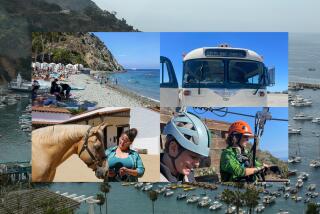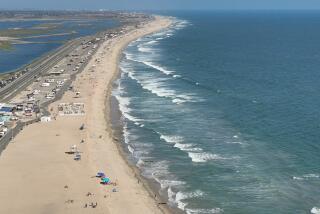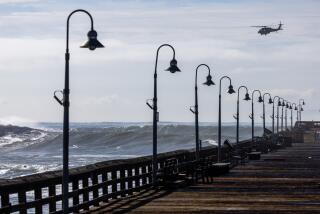Harboring Doubts
With warm, dry days expected through May, officials say spring will be a busy time for the harbors in Ventura and Oxnard.
As boaters head for the ocean to escape what National Weather Service forecasters say will be three months of unseasonably warm weather, many will discover that their boats have not made it through winter storage as well as expected.
Fuel can foul, oil can become dirty, and what started out as a small crack after a boat ran aground in December can lead to a leak of disastrous proportions by April. And whether a boat is 16 or 60 feet long, the time for boaters to make step-to-stern repairs is now, before they head off on day trips and longer voyages, experts say.
If the weather along the coast holds true to the 90-day forecast, âthings are going to be a little bit drier and warmer than normal,â said Stuart Seto, weather specialist with the National Weather Service in Oxnard.
The chance of rain now is 22% per day, and that drops to just 13% by April, Seto said.
In addition, weather experts say there is a 43.33% chance for temperatures along the coast to be above normal through May. The average high temperature in Ventura County in March, April and May is about 60 degrees, and highs are likely to exceed that through the beginning of summer.
The increased temperature means boaters will be out in force.
Already, the Ventura Port District is getting the word out to boaters that a little bit of work now can prevent disaster later on, said Scott Miller, operations manager for the port district.
*
âTheir boats havenât been used since last summer and they think theyâre going to run just like they did last summer,â Miller said.
Among the handful of maritime surveyors who inspect private and commercial vessels in Ventura and Santa Barbara counties is 45-year-old Skip Riley, director-at-large of the National Assn. of Maritime Surveyors Southern Section and owner of Channel Islands Harbor-based Maritime Surveyors.
A preseason stem-to-stern inspection can help the owner determine the seaworthiness of his or her boat, said Riley, a former deputy Ventura harbor master. King Neptune welcomes any type of boat to join him at the bottom of the sea, Riley said, and the inspection, which averages about $250, can help ensure that a boat, whether it be a sedan cruiser made of fiberglass or a wooden sailboat, never meets that fate.
âThe purpose of the boat inspection is to keep water out of the boat and keep us on the boat,â Riley said.
The National Assn. of Maritime Surveyors prohibits those who do the inspection from performing the repair work on the vessel, Riley said.
That work is left to boat repairmen such as Brad Fry of Hollywood Beach who on a recent afternoon was performing âboatyard triageâ on a Korean-built sailboat at the Anacapa Boatyard in Oxnard.
âThe problem with these boats is that they can develop leaks in the rudder,â said Fry, 40, his face covered in fiberglass dust and his eyes protected by sunglasses.
Water had leaked into the 4-foot rudder through a break in the laminated surface, and Fry drained it and dried it by drilling holes at the bottom. Once the rudder has dried out, the holes will be filled with fiberglass. Fry will then sand the new material down smooth and the entire rudder will receive a new coat of waterproof paint before being returned to its guides on the sailboat.
Experts say boating safety is as important as a safe boat. That means making sure flares and life preservers, horns and running lights are in working order, Riley said.
*
Safety also means being aware of speed limits in and around harbors, and knowing the unique characteristics of each harbor, according to Miller.
âOne of the things that makes this harbor unique is the sand trap behind the north side of the breakwater. The north side of the harbor is not an entrance. The south side of the breakwater is the entrance,â Miller said of the Ventura Harbor.
Also, the Santa Clara River south of the Ventura Harbor dumps sand in the ocean near the harbor, and because of that boaters leaving the harbor should not head south before passing the clearly marked No. 2 buoy, located about three-fourths of a mile outside the harbor.
One of the problems that has faced the Ventura Harbor Patrol in recent years is the increased use of personal watercraft in the harbor, Miller said. On an average warm weekend day, deputy harbor masters make frequent stops of people exceeding the 5 mph speed limit inside the harbor.
*
âA lot of them are brand-new here, and they just donât know the rules,â Miller said.
The Harbor Patrol was spending so much time stopping people on jet skis and similar equipment last year that officers began handing out fliers to the watercraft users at the dock, before they even got into the water.
While patrolling the harbor on a recent afternoon, Miller stopped John Ainsworth and his son, Brennen, for allegedly exceeding the speed limit on their jet skis.
Ainsworth, 42, said he and his son had never been to the harbor and neither was aware of the speed limit.
âWe were told once we got around the corner we could go as fast as we wanted. I guess it was the wrong corner,â Ainsworth said.
(BEGIN TEXT OF INFOBOX / INFOGRAPHIC)
FYI
To learn more about boating safety or to sign up for a boating safety course, call the U.S. Power Squadron at (800) 732-7545, or John or Zane White of the U.S. Coast Guard Auxiliary at 483-0534.
More to Read
Sign up for Essential California
The most important California stories and recommendations in your inbox every morning.
You may occasionally receive promotional content from the Los Angeles Times.










